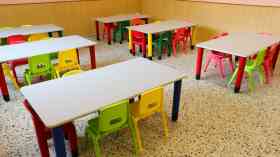
Temperature, ventilation and air quality in schools
Ashley Bateson from the Chartered Institution of Building Services Engineers, which recently launched its HVAC Systems Group, considers the changing regulations around ventilation in schools and what they will mean for air quality and the comfort of pupils
New rules on air quality in classrooms are expected to come into force later this year. The draft of Building Bulletin 101: Guidelines on ventilation, thermal comfort and indoor air quality, makes a number of key changes from the current document (Building Bulletin 101: ventilation for school buildings).
The changes have been introduced to minimise the risk of classrooms overheating and to control carbon dioxide (CO2) levels in classrooms in line with the Education and Skills Funding Agency’s Facilities Output Specification.
As such, the revised document draws inspiration from the last 10 years of school design as well as other guidance, such as the Priority School Building Programme (PSBP), the CIBSE Technical Memorandum (TM52:2013), The limits of thermal comfort: avoiding overheating in European buildings, and Approved Document L2A of the Building Regulations, to deliver a greater emphasis on energy efficiency and indoor comfort.
The revised document is currently on hold, possibly until after a wider review of Building Regulations which is currently taking place following the Grenfell Tower tragedy. Nevertheless, the revisions are expected to be adopted and they will have both practical and economic implications for the design and refurbishment of schools.
Thermal comfort Perhaps the most significant change proposed is the introduction of the concept of adaptive thermal comfort; how the occupants perceive temperature, based on a number of variable factors, rather than the fixed benchmark temperature thresholds used in the current edition of BB101, as a way of defining occupants’ thermal comfort. As such, adoption of the new guideline will provide a more flexible and accurate assessment for the operation and lifetime of the building in terms of occupant thermal comfort.
The revised document also addresses the problem that in some classrooms CO2 levels rise above recommended levels in winter because windows remain closed to prevent cold draughts upsetting the occupants. In the revised document, it
will be a requirement for building services engineers to assess draught risk by checking the air velocity and temperature.
In reality this requirement means that the option of providing fresh air to a room by opening the windows cannot be the sole method of ventilation. So, in addition to the two current strategies for introducing fresh air into classrooms, natural ventilation and mechanical ventilation, the revised document includes a new ventilation category termed ‘hybrid’ or ‘mixed mode’, which is a combination of the mechanical and natural ventilation.
Ventilation categories
Natural ventilation has been used traditionally to provide comfort and supply fresh air to classrooms simply by opening windows and allowing the wind and/or buoyancy forces (whereby warm air rises pulling in cooler air to replace it) to move air through the space. The downside is that, aside from opening and closing windows, the system is uncontrollable and can cause draughts. Similarly, if a school is near a busy road, noise and pollution may prevent windows being opened. Mechanical ventilation systems were introduced to overcome some of these issues. Generally, they use a fan to push fresh air into a classroom and to pull stale air from the room. These systems also filter the air and pass it through a heat exchanger to warm it in winter before supplying it to the room.
The downside is that running a fan means that these systems consume energy throughout the school day. The new guidelines also prevent designers using mechanical ventilation as the sole means of ventilation, particularly in the summer, when it should be possible to provide fresh air by opening the windows, or vents, to provide sufficient fresh air.
A hybrid – or mixed-mode – system introduces outdoor air into a building by both mechanical and passive means. These systems employ natural driving forces of the wind and the stack effect, and when natural forces alone do not result in the CO2 requirements being met, they boost air movement using a fan.
Maintenance and cleaning
So what are the maintenance and cleaning issues of heating and ventilation systems for schools? The advantage with natural ventilation systems is that opening and closing windows has no maintenance cost. However for mechanical and hybrid systems the design should ensure that fans and filters should be easily accessible for maintenance and easy to clean.
Filtration may be needed for two reasons: to prevent dirt accumulating in the ventilation system and/or to filter out pollutants. Filtering out pollutants that have health effects requires more expensive filters whereas less efficient and cheaper filters can be used simply to protect air handling plant.
Similarly, heat exchangers should be able to be inspected to ensure that they are not contaminated. Air ducts and plenum spaces used for ventilation should be accessible and easily cleanable. Air handling units with filters may be fitted with filter alarms to send a fault signalto the maintenance team to indicate that filters are dirty and need to be changed.
School kitchens will be ventilated using an independent ventilation system designed specifically for the kitchen, which will operate only when the kitchen is in use. School kitchens typically use gas-fired cooking appliances. However, some low energy school kitchens are now starting to use electric induction cooking, which means there are no combustion gases to be removed and waste heat from around the pans is minimised. This enables the total ventilation rate to be reduced significantly.
Kitchen ventilation systems will generally be designed in accordance with a document known as DW/172: Specification for Kitchen Ventilation Systems. This document reflects current legislation and the latest cooking techniques and design of catering equipment.
In terms of cleaning, it is the grease extracted by the ventilation system that should be collected and removed so that it does not accumulate in either the kitchen extract canopy or the ductwork system. Grease filters should be removable and installed so that they are accessible for cleaning and maintenance. CIBSE provides guidance on the hygienic maintenance of ductwork in CIBSE TM26.
Energy
Heating and cooling systems can be some of the largest users of energy in schools, they are also some of the hardest services to decarbonise and manage effectively. As national policy turns to the challenge of low carbon heat, CIBSE has launched a HVAC Systems Group to support and encourage efficient design, installation and operation of heating, ventilation and air conditioning systems.
Launched at the end of last year, the new CIBSE Group will provide a ready means for sharing of new developments and experience in the effective design and operation of low carbon heating, ventilation and cooling systems. The new group aims to broaden knowledge and awareness of the strategic and practical issues, the latest developments and new technologies related to HVAC systems.
The group will also identify knowledge gaps in the design and operation of HVAC systems to promote research in these areas in addition to contributing to the development of new publications and the maintenance of existing guidance.
Ashley Bateson is head of sustainability at engineering consultant Hoare Lee. He is a board member and current Vice President of CIBSE.
Further Information:Latest News
17/12/2025 - 09:31
Ofqual has fined exam board Pearson more than £2 million in total for serious breaches in three separate cases between 2019 and 2023 which collectively affected tens of thousands of students.
16/12/2025 - 09:19
The average funding rates will increase by 4.3% for under 2s, and by almost 5% for 3-and-4-year-olds.
15/12/2025 - 10:30
Local colleges are set to receive £570 million in government funding to expand training facilities in areas such as construction and engineering.
12/12/2025 - 11:39
The government has announced at least £3 billion to create tens of thousands of new specialist SEND places in mainstream schools.
12/12/2025 - 07:07
The findings suggest that children and young people attending schools in the North of England are less likely to take part in and benefit from residential visits.







